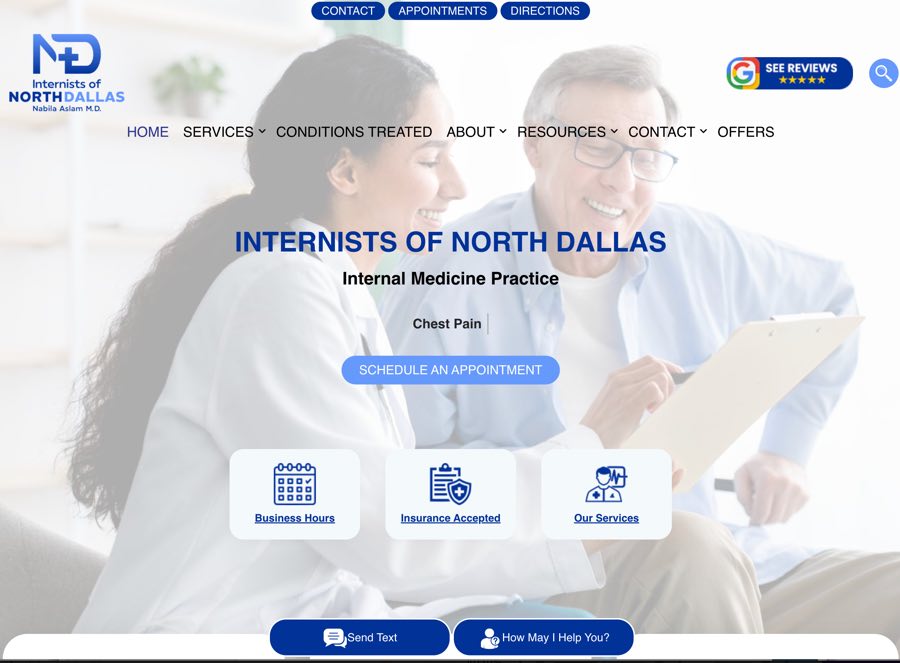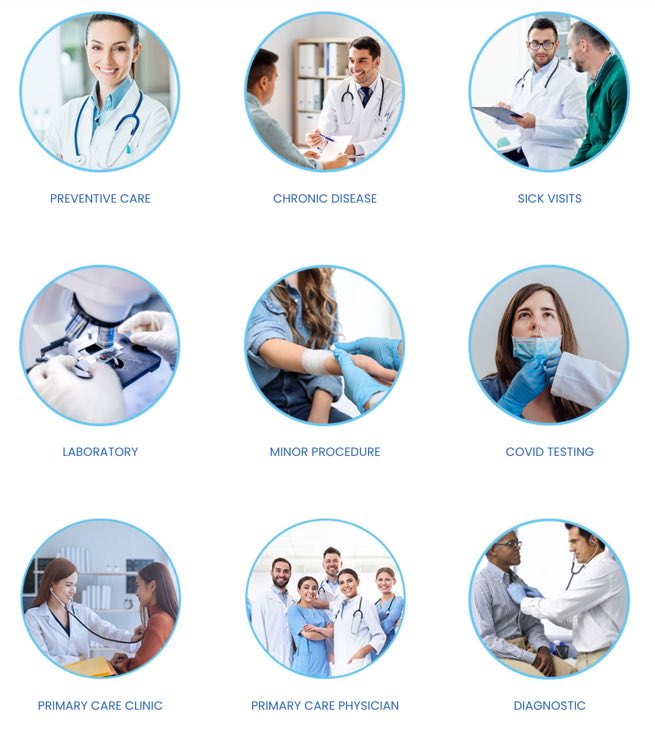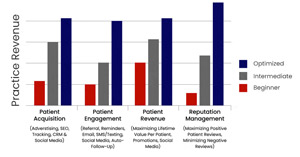Expert Marketing for Internal Medicine Practice $799/mon to $999/mon Complete Solution Including Website
There are approximately 120,342 active physicians practicing internal medicine in the United States. They all need a simple and cost effective marketing solution, so they can focus on practicing medicine.
Digital Marketing for internal medicine practices costs $799/mon to $999/mon, this is a complete solution including the website, SEO, and 20 additional HIPAA compliant apps. By focusing on treatments offered by your practice, we are able to attract more new patients for your practice. There are many different strategies to advertise and market your internal medicine practice, however we focus on the strategies that return good ROI (return on investment) for your practice. As a practice, you can focus on many treatment areas. We have found that many internal medicine providers focus on specific type of patients and treatments. These treatment areas typically include endocrinology, rheumatology, infectious diseases, geriatrics, rehabilitation medicine, heart disease, diabetes, weight loss & wellness, and functional medicine. The list is endless, and PatientGain has the expertise, experience, technology, HIPAA compliance and awesome customer service to help you.

What is a marketing expert for internal medicine practices?
A marketing expert for internal medicine would be someone skilled in promoting and attracting patients to internal medicine practices or related healthcare services. They would need to understand the nuances of internal medicine and be able to tailor their marketing efforts to resonate with the target audience.
Many people confuse an internal medicine clinic for a family medicine clinic. It is essential to ensure that your digital marketing plan helps potential patients determine if an internal medicine clinic is right for them. The marketing plan needs to be designed so that the right people walk through your front door and be as efficient as possible when spending marketing money.

What is the difference between a family medicine clinic and an internal medicine clinic?
Overall, both of these medical practices treat people with conditions. However, the focus of each clinic is vastly different. A family medicine clinic is focused on the family as a social unit. They are trained to handle the common medical issues that a family will experience. An internal medicine clinic, however, will generally focus on specific areas of medicine. It isn’t uncommon for a family doctor to send a patient to an internal medicine specialist for more specialized treatment and care. Some areas an internal medicine clinic will specialize in are:
- Endocrinology
- Rheumatology
- Infectious diseases
- Neurology
- Geriatrics
- Heart disease
- Diabetic patients
- Medical weight loss
- Psychiatry
- Dermatology
- Ophthalmology
- Office gynecology
- Otorhinolaryngology
- Non-operative orthopedics
- Palliative medicine
- Sleep medicine
- Geriatrics
- Rehabilitation medicine
How can a website help an internal medicine clinic attract new patients?
As you can see from the list above, many medical names cover areas of medicine. As a doctor, these all may be very familiar terms to you. For the general public, they are not. A website is a marketing property that almost every new patient to an internal medicine clinic will visit. It not only needs to make a good impression, but it also needs to educate potential patients that they have selected the right place for treatment. The more unique, educational content on a website, the more likely it is to convert a website visitor to a patient. An owner of an internal medicine clinic should assume the majority of its new website visitors do not have a firm grasp on what the clinic does or the area of medicine it specializes in.
How can search engine optimization help an internal medicine clinic attract new patients?
Search engine optimization, also known as SEO, is vital for the success of any medical website. It is crucial for an internal medicine clinic. It is unlikely that a potential patient will know the official medical name of their condition or the medical field an internal medicine doctor is specializing in. They will often use as search terms their symptoms or familiar names for their medical issues when they are searching online. They also may ask complete questions in search engines, hoping to get the answer in the results.
To effectively use SEO to boost the ranking of your website, these words, phrases, and questions need to be sprinkled throughout your content. If a website contains the exact term or question a potential patient uses in their search, it stands a much better chance of appearing as a top result. With that said, SEO Keywords can not be plastered in every paragraph of every page. This tactic is frowned upon by major search engines and will result in ranking penalties. Instead, it should be spread out and be relevant to the pages.
How should an internal medicine practice use content marketing to attract patients?
Content marketing is a cost-effective way to boost the organic rankings of an internal medicine’s website and often works hand in hand with search engine optimization. Search engines like to see expansive, unique, informative, and engaging content. The more content you have on a website, the more authoritative your site will appear. It also will cause potential patients to spend more time on a website to educate themselves, another factor that adds to good site rankings.
Internal medicine clinics needs excellent content on their websites because not everyone visiting knows precisely what that specific doctor does in terms of medical treatments. With that in mind, it is helpful to dedicated pages talking about the conditions, treatments, and reasons why someone would visit that clinic. Here, some doctors make a mistake by simply cutting and pasting content from other websites or medical journals to explain what they do at that location. This tactic will not help your overall rankings and actually may hurt it. Instead, write out content that is unique to your location and in your own words. Of course, a practice can take inspiration from other sources, but putting it in unique words will help the website’s overall ranking. The top priority is for the content to be unique and valuable to patients with a clear call to action.
Why should an internal medicine clinic install a medical engagement chatbot onto its website?
Chatbots are programs that mimic human conversation and help people find information or accomplish specific tasks. The retail industry has effectively used these chatbots to boost sales on their websites. The healthcare industry has also come to use chatbots to drive conversions effectively. An internal medicine clinic can also use a chatbot to help current and potential patients find what they are looking for on the site.
A chatbot will be a program by an internal medicine clinic to answer a specific set of questions. These questions should be the most common questions staff gets over the phone or through email. Ideally, a chatbot should help those people, freeing up the time for staff to deal with more complex problems. If a clinic is unsure what questions to program into a chatbot, ask the front desk staff what questions they receive the most and include them. Also, have simple tasks that patients may not be sure how to accomplish, like making an appointment or the directions to the clinic. Carefully thinking out the type of questions your current and potential patients will ask and it will help make your entire clinic much more efficient.
The most beneficial aspect of a medical engagement chatbot is that it does not take days off, needs time for lunch, and is available 24 hours a day every day of the year. A medical chatbot is available as long as a patient has an internet connection. When a chatbot can not answer a question, many will then take the person’s contact information and forward it to staff using a secure dashboard. This allows staff to answer questions during the day and check in the morning to see if there was any activity overnight. They would much prefer this than deciphering voice mail messages or picking out emails among junk email responses.
How vital are site speed and mobile-friendliness to an internal medicine website?
Site speed and mobile-friendliness have a significant impact on the organic rankings of an internal medicine website. No matter how great the website’s content or the fantastic selection of keywords are, having a slow-running website that does not function on mobile devices will significantly hurt your patient count. It is also a factor in Google’s SEO ranking algorithms. It is practically having a $100,000 car but trying to use cooking oil as gasoline. It looks nice, but you will not get very far.
Most visitors to a website will give you a few of seconds to catch their attention and make an excellent first impression. If that fails to happen, they will lose interest and move on to other results. The speed of an internal medicine’s website is critical in this respect. For every second it takes for a website to load, more potential patients look at other results. If a medical webpage takes more than 4 seconds to load, it puts a clinic at a severe disadvantage to its competitors. The most common problems that will slow down a website are:
- Unoptimized pictures.
- Videos trying to load directly to a website.
- Code interfering with other parts of the website.
- Old software running your website
- Website hosting is cheap, and servers are shared with very limited resources like memory, CPU, caching
- Company managing your medical website has not paid attention to your website performance
- User experience and fast loading websites go hand-in-hand, learn more here
Images need to be reduced in size to load quickly on a website, and videos should be hosted on 3rd party sites and embedded into the website. Codes should be updated regularly to ensure they are running correctly. Finally, a website should load quickly on all devices: Desktop, Mobile, and Tablets.
Speaking of mobile devices, an internal medicine website absolutely must be mobile-friendly. Every function available on a desktop version of the website needs to be available and easy to access on the mobile version. While some practices maintain a separate “desktop version” and a “mobile version” of their website, the best way to approach this is to have a responsive website. As the name suggests, the website will “respond” to the screen’s size and adjust to fit automatically. A mobile website needs to be easily navigated, read, and effective at helping patients. While this may have been impossible to imagine a decade ago, more often than not, the majority of website traffic coming to a clinic is through a mobile device. With that in mind, a mobile website should be considered a top priority for a medical practice.
Are there any traditional or offline marketing techniques an internal medicine clinic should consider?
Although digital marketing has undoubtedly taken the lead in overall marketing plans for internal medical practices, some traditional or offline marketing strategies are effective. To get the most out of them, a clinic should use them in conjunction with other digital marketing techniques. When someone is exposed to traditional marketing, they are often sent to a digital property, like a website, for more information.
Direct Mail Marketing
Direct mail marketing remains a cost-effective way to promote an internal medicine clinic to surrounding neighborhoods. This is often effective in reaching people who may not need your services now but in the future. It also can reach people who may not be as internet savvy and therefore requires something physical to hold and tell them about an internal medicine clinic. With mail volume dropping every year, this gives practices an added advantage of not competing with other things in the mail. Using different color paper, thickness, and pictures is a great way to make mail stand out among other mail pieces. Everything mailed to a household should have a clinic’s address, website URL, phone number, and a call to action. To gauge the effectiveness of a direct mail campaign, you should expect to see a bump in “Direct URL” traffic in web analytics.
Interviews & Stories in Media
Getting a TV station, Radio station, or a newspaper to write an article about an internal medicine practice is very difficult. The best chance for this to happen is when it opens and provides a new service to the community or an underserved population. It can also occur when a new service is unique to the community or is for an underserved community. While it never hurts to send out press releases, it will be challenging to get their attention.
Instead, offer your doctors as experts to the media when they need expert opinions in their news pieces. These opportunities will not feature an internal medicine practice in the story, but the doctor will be featured prominently, and the story will indicate where they work. Online versions of these stories may even have a link to an internal medicine practice’s website. Even something like this, “Dr. Smith, who specializes in cardiac medicine at ABC Internal Medicine says…” can be very valuable to a clinic. These opportunities often appear randomly and out of nowhere, so try your best to be as available as possible.
Another route many internal medicine clinics employ for getting their names in the media is offering to write guest columns for newspapers. Again, this column can not promote the medical practice as the subject but instead talk about a local or regional health concern. Written by a doctor working at the practice, it will showcase their expertise, and often there will be a short bio about the doctor, where they work, and a link back to the clinic. These links from 3rd party websites are precious and will help boost overall organic rankings.
The experts at PatientGain.com can help you promote your internal medicine clinic and boost your patient count. Call our experts today, and let us show you what we have done for other internal medicine clinics across the country!


